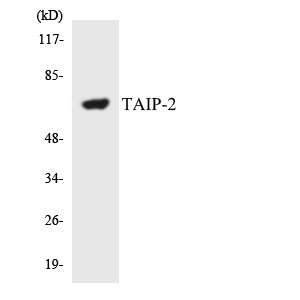CSRNP3 Polyclonal Antibody
- Catalog No.:YT1142
- Applications:WB;ELISA
- Reactivity:Human;Mouse;Monkey
- Target:
- CSRNP3
- Gene Name:
- CSRNP3
- Protein Name:
- Cysteine/serine-rich nuclear protein 3
- Human Gene Id:
- 80034
- Human Swiss Prot No:
- Q8WYN3
- Mouse Gene Id:
- 77771
- Mouse Swiss Prot No:
- P59055
- Immunogen:
- The antiserum was produced against synthesized peptide derived from human TAIP-2. AA range:171-220
- Specificity:
- CSRNP3 Polyclonal Antibody detects endogenous levels of CSRNP3 protein.
- Formulation:
- Liquid in PBS containing 50% glycerol, 0.5% BSA and 0.02% sodium azide.
- Source:
- Polyclonal, Rabbit,IgG
- Dilution:
- WB 1:500 - 1:2000. ELISA: 1:20000. Not yet tested in other applications.
- Purification:
- The antibody was affinity-purified from rabbit antiserum by affinity-chromatography using epitope-specific immunogen.
- Concentration:
- 1 mg/ml
- Storage Stability:
- -15°C to -25°C/1 year(Do not lower than -25°C)
- Other Name:
- CSRNP3;FAM130A2;TAIP2;Cysteine/serine-rich nuclear protein 3;CSRNP-3;Protein FAM130A2;TGF-beta-induced apoptosis protein 2;TAIP-2
- Observed Band(KD):
- 64kD
- Background:
- function:Binds to the consensus sequence 5'-AGAGTG-3' and has transcriptional activator activity. Plays a role in apoptosis.,sequence caution:Unusual initiator. The initiator methionine is coded by a non-canonical CTG leucine codon.,similarity:Belongs to the AXUD1 family.,
- Function:
- function:Binds to the consensus sequence 5'-AGAGTG-3' and has transcriptional activator activity. Plays a role in apoptosis.,sequence caution:Unusual initiator. The initiator methionine is coded by a non-canonical CTG leucine codon.,similarity:Belongs to the AXUD1 family.,
- Subcellular Location:
- Nucleus .
- Expression:
- Embryo,Thymus,
- June 19-2018
- WESTERN IMMUNOBLOTTING PROTOCOL
- June 19-2018
- IMMUNOHISTOCHEMISTRY-PARAFFIN PROTOCOL
- June 19-2018
- IMMUNOFLUORESCENCE PROTOCOL
- September 08-2020
- FLOW-CYTOMEYRT-PROTOCOL
- May 20-2022
- Cell-Based ELISA│解您多样本WB检测之困扰
- July 13-2018
- CELL-BASED-ELISA-PROTOCOL-FOR-ACETYL-PROTEIN
- July 13-2018
- CELL-BASED-ELISA-PROTOCOL-FOR-PHOSPHO-PROTEIN
- July 13-2018
- Antibody-FAQs
- Products Images

- Western blot analysis of the lysates from HepG2 cells using TAIP-2 antibody.



